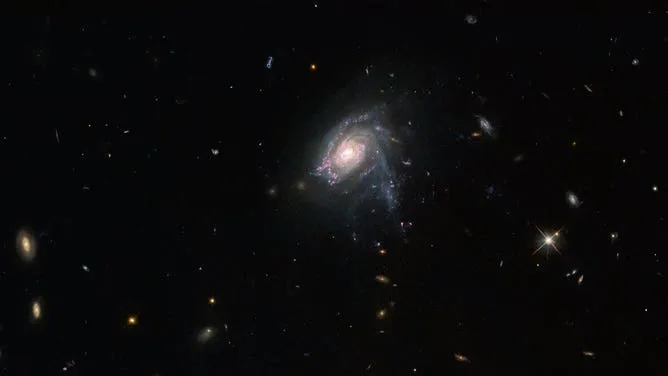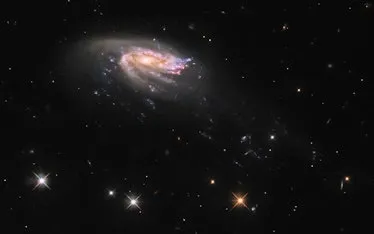The Hubble Space Telescope has captured stunning images of a unique type of galaxy that bears an uncanny resemblance to a jellyfish. Known as jellyfish galaxies, these celestial bodies feature long, trailing tendrils that give them their characteristic appearance. The latest addition to this celestial family is JO206, a galaxy located 700 million light-years away in the constellation of Aquarius.
At first glance, JO206 appears to be a typical spiral galaxy, with a bright central core surrounded by a disk of stars and dust. However, as the image zooms in, the viewer is treated to a sight that is both breathtaking and baffling. The galaxy’s center is surrounded by a network of thin, wispy filaments that stretch out like tentacles, giving the galaxy its jellyfish-like appearance.
But what causes these tendrils to form? According to astronomers, they are the result of a process called ram pressure stripping. When a galaxy moves through a galaxy cluster, it encounters a diffuse cloud of plasma gas known as the intracluster medium. This gas is hotter than the surrounding space outside the cluster, and as the galaxy moves through it, it creates drag, which pushes gas out of the galaxy and causes it to form a long tail that trails behind the galaxy’s main body.
Hubble has previously captured images of other jellyfish galaxies, including JO201 and JW100. However, the newly released image of JO206 offers a unique opportunity for astronomers to study these galaxies in greater detail. One of the most intriguing aspects of jellyfish galaxies is the high rate of star formation in their tails. Astronomers have long been curious about how star formation might differ when it occurs far away from a galaxy’s center.

Jellyfish Galaxy JO206
Surprisingly, Hubble’s observations suggest that the process of star formation is remarkably similar, whether it occurs in the center of a jellyfish galaxy or at the edges of its tails. According to Hubble scientists, “The tentacles of jellyfish galaxies give astronomers a unique opportunity to study star formation under extreme conditions, far from the influence of the galaxy’s main disk.” And yet, despite the dramatic differences in environment, the star-forming process appears to be remarkably consistent.
This discovery has significant implications for our understanding of the universe. It suggests that the environment in which stars form may have a relatively minor influence on the process itself. Instead, other factors such as the presence of gas and dust may play a more significant role in shaping the formation of new stars.
As astronomers continue to study jellyfish galaxies like JO206, they are likely to uncover even more secrets about the universe. These galaxies offer a unique window into the extreme conditions under which stars form, and the insights gained from studying them may have far-reaching implications for our understanding of the cosmos.
The image of JO206 is just one of the many stunning pictures taken by the Hubble Space Telescope. With its ability to capture high-resolution images of distant galaxies, Hubble has revolutionized our understanding of the universe, revealing wonders that were previously unimaginable. And as the telescope continues to observe the cosmos, it is likely to uncover even more surprises, each one offering a Look into the mysteries that remain to be solved.









































